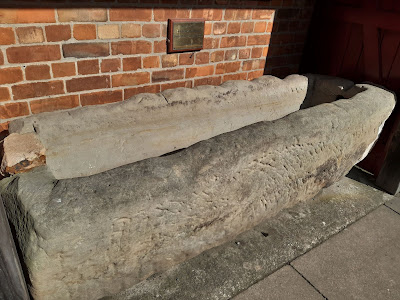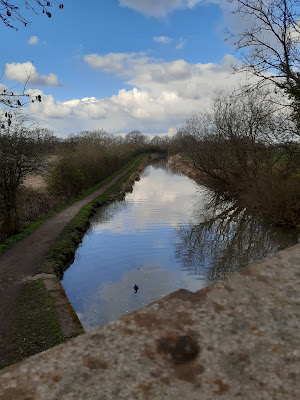I was chauffeuring Son the Elder to a roboteering event in Leicestershire yesterday, and as it wasn't far from Coventry where Son the Younger now works, we decided to meet up. I don't know that part of the country at all well, but as it happens my publishers, Ronnie and Dawn of Indigo Dreams, used to live in the next village, and gave me lots of suggestions for places to visit, from which we chose the Bosworth Battlefield trail. First, though, a battle with the car parking meter at Sutton Wharf, which was refusing to issue tickets.
On, then, along the Ashby canal for a short way - just far enough, in fact, to admire a very bold kestrel which passed quite close by us ...
... and this piece of spalted wood which turned out to be not spalted at all, but faux-crackled with some sort of blackened vegetation ...
... before turning up through Ambion wood to the Visitor Centre. Inexplicably, Son the Younger decided to rely on my largely fanciful grasp of history instead of the carefully curated exhibition, so after admiring the Earl Shilton stone coffin (Earl Shilton being a place, not a person), which was believed for many years to be that of King Richard III and which has Romano-British tool marks on its side ...
... and the stocks ...
... we decided to start the battlefield walk. Now, the problem with history is that it often happened a long time ago, and there's no one alive from 1485 to say with any precision just where Bosworth Field was. And so after more than 220 years of thinking you know exactly where it was, and just when you have got your marker stone set up ...
... some bright spark discovers the inconvenient truth that it wasn't there at all, and gets loads of plaudits, while you're left with a massive boulder marking the wrong spot altogether.
It's even worse when you've established the Heritage Centre in a 14th century tithe barn that's handily nearby, and stuck your flagpoles up with your Yorkist and Tudor flags ...
... and hell's teeth, even built your Richard III sundial with commemorative thrones. Now, after centuries of mistaken celebration, Ambion Hill has been returned to arable use.
Down at Shenton Station we saw a diesel train advertising the rather optimistic destination of Scarborough. (It actually goes just a few miles up the track to Shackerstone.)
We walked back towards Sutton Wharf along Shenton cutting, which is no longer in use.
A short detour past the turning to the canal takes you to what is currently believed to be the site of the battlefield, where, on 22nd August 1485, Henry Tudor's small rebel army defeated the much larger Royal army of King Richard III, with Richard hemmed in by marsh and cut down 'in the thickest press of his foes'.
I think the historians might have the right location this time, as the reedmace in the far corner looks like spears coming into view.
Marsh marigold
Back at Sutton Wharf, we watched the kestrel which was still hunting and ate lunch outside in the sun. After a bit it started to snow. We vacated the seats by the cafe and watched the driver of a hire boat hurtle into view, scraping the boat along the concrete edge of the tow path.
By now shift-working son was getting sleepy, so we headed back to robot land, and I read in the car till it was time to set off for home. Another small jaunt in this time of pandemic. I'll take what I can get.




















No comments:
Post a Comment